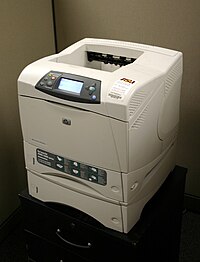
Photo from wikipedia
Self-limiting assembly of particles represents the state-of-the-art controllability in nanomanufacturing processes where the assembly stops at a designated stage, providing a desirable platform for applications requiring delicate thickness control such… Click to show full abstract
Self-limiting assembly of particles represents the state-of-the-art controllability in nanomanufacturing processes where the assembly stops at a designated stage, providing a desirable platform for applications requiring delicate thickness control such as optics, electronics, and catalytic systems. Most successes in self-limiting assembly are limited to self-assembled monolayers (SAMs) of small molecules on inorganic, chemically homogeneous rigid substrates (e.g., Au and SiO2) through surface-interaction mechanisms. Similar mechanisms, however, cannot achieve a uniform assembly of particles on flexible polymer substrates. The complex configurations and conformations of polymer chains create a surface with nonuniform distributions of chemical groups and phases. In addition, most assembly mechanisms require good solvent wettability, where many desirable but hard-to-wet particles and polymer substrates are excluded. Here, we demonstrate a collision-based self-limiting assembly (CSA) to achieve wafer-scale, full-coverage, close-packed monolayers of hydrophobic particles on hydrophobic polymer substrates in aqueous solutions. The kinetic assembly and self-limiting processes are facilitated and controlled by the combined acoustic and shear fields. We envision many applications in functional coatings and showcase their feasibility in structural coloration. Importantly, such functional coatings can be repaired using CSA, and both particles and polymer substrate can be recycled.
Journal Title: ACS applied materials & interfaces
Year Published: 2022
Link to full text (if available)
Share on Social Media: Sign Up to like & get
recommendations!